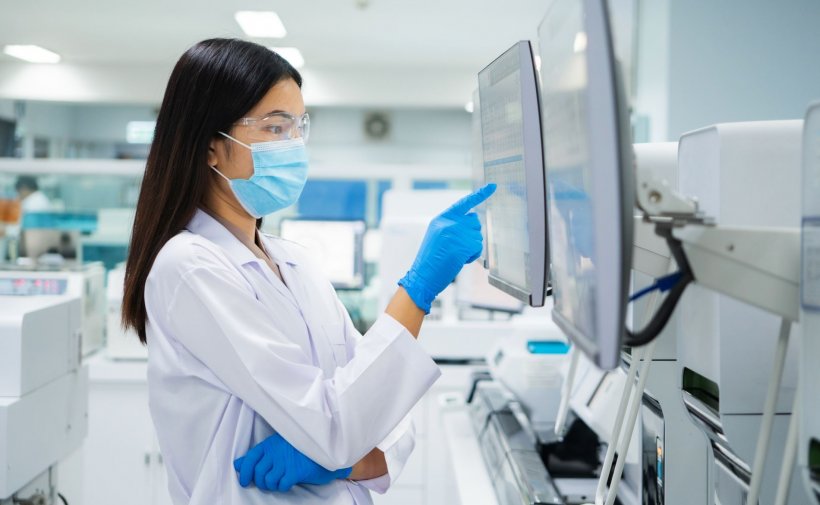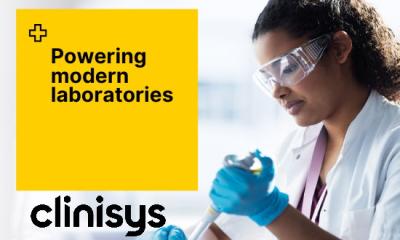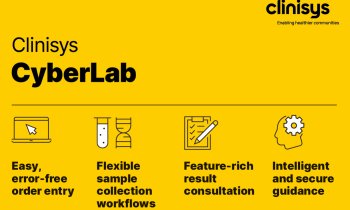
Image source: CliniSys
Sponsored • Demand for molecular LIMS increases
Lab interoperability is essential
Fast, flexible laboratory information management systems (LIMS) that cope with data and workflow complexities of molecular and genetic testing now work in laboratories internationally. Here, in the first in a new Lab Pinnacle Series, experts from the CliniSys Group, Sunquest Information Systems and Data Innovations (all owned by Roper Technologies), discuss the value of a LIMS in molecular and genetic testing.
When precision medicine initiatives gained momentum in the USA, observed Laura Voeghtly (Sunquest), clinicians focused on molecular testing, which was new to many of them. Thus, higher volume and greater test complexity needed support, and clinicians needed to know the diagnostic, prognostic, and therapeutic implications of test results. Thus, LIMS automation, instrument integration and general laboratory interoperability became essential.
To deliver a genomic medicine service, NHS England commissioned seven Genomic Laboratory Hubs (GLHs) and developed a National Genomic Test Directory for GLHs. The initiative includes goals for standardisation, equity of access to testing, economies of scale, and volume growth that are collectively increasing demand for well-integrated LIMS technology, said Steve Abbs (CliniSys).
Genetics and genomics tests are very complex and specialised, which calls for specialised technology that integrates with all necessary databases and systems from order to invoicing
Stéphane Decap
‘NHS labs also do a lot of genetic testing for infectious disease,’ Tony Oliver (CliniSys) pointed out. ‘Just think of Covid-19 to grasp the volume of molecular PCR amplification techniques and sequencing events. Those are generally done in metropolitan teaching hospitals, but with the commoditisation of molecular testing, we see a greater need for specialised LIMS technology.’
Stéphane Decap (CliniSys) pointed to a sharper distinction between molecular and genetics tests in the EU. Molecular techniques are routine for human genetics and by other labs, for example for virology. University hospitals mostly cover human genetics testing but genetics markets vary greatly between countries, e.g. in Germany many private labs do human genetics tests, but France has only a few, and only two genomics hubs do full genomics testing. ‘The need for GLIMS – our lab information system that supports genetics – has not been as high in France or Belgium; but, as those countries follow the UK’s increased testing, demand will grow. Genetics and genomics tests are very complex and specialised, which calls for specialised technology that integrates with all necessary databases and systems from order to invoicing.’
LIS or LIMS?
‘LIS are built to accommodate clinical pathology, so they can be fairly rigid in their database structures,’ Shirley Li (Sunquest) underlined. ‘With molecular and genetic testing, applying different ways to sequence new modules requires a flexible, agile workflow solution. The application of different assay technologies varies among laboratories and even for a given instrument there can be differences in analysis and data interpretation needs.’
Next generation sequencing (NGS)
‘This needs more sophisticated analysis for bioinformatics, which can also differ from one lab to another. LIMS can be key to supporting the right level of configurability and modularity for labs to define their own plans and strategies in this field.’
‘We can work with middleware partners to support molecular workflows,’ said Filip Migom (CliniSys), adding, ‘Within the human molecular testing domain, if your focus is testing with yes/no results, a traditional LIS can handle that. However, if you want to do more complex procedures, it’s better to manage this outside the standard LIS. Techniques change rapidly, but generic approaches are possible, as done in Europe with our GLIMS. We’ve built a special purpose module, GLIMS Genetics, to support the flexible workflows needed in those environments. Instead of dedicated haematology or biochemistry modules, we have a more general approach, so we can support some complex workflows.’

Image source: CliniSys
Middleware
‘Across the board, interfacing gives you efficiency, quality, and scalability,’ said Carol Beth Casto (Data innovations). ‘For molecular and genetic testing, instrument interfacing is in its infancy. Different molecular and genomics labs have different workflows. At Data Innovations, we are making inroads with workflow variability by establishing that standard, lower-level protocol for the output, and able to tweak here and there. We work with instrument vendors and LIMS systems to provide standardised translation from the system to the instrument and back with our Instrument Manager middleware.’
‘In Europe, test orders come in and results go out through different systems with different protocols, formats and languages,’ Filip Migom explained. ‘Middleware enables our GLIMS to manage all those variables. We must translate all types of requests to standardise within our database, and then we must translate again for the reporting and business side. In the middle, we must also translate all the interoperability with the instruments because performing a download of a plate depends on the instrument technique and reporting code. Middleware plays a key role in facilitating this level of integration and interoperability.’
When should molecular testing be brought in house and LIMS be implemented?
‘For private labs, when it can be profitable,’ answered John Lebon (CliniSys). Plan early, he advised; volumes grow beyond the capabilities of the current LIS. Interfacing with variant analysing systems within healthcare systems is difficult and often performed manually.
Shirley Li agreed: profitability is the primary driver in the USA – i.e. scalability and reimbursement above cost. Looking at NGS, about two-thirds of lab costs are for reagents. Additional efficiencies in staff time and resource allocation are worthwhile. ‘Moving from paper-based, offline systems into something like Sunquest Mitogen LIMS helps understand where lab costs are and how to improve cost analysis measures.’
Holding power within an institution
If a testing method emerges that drastically reduces lab costs, labs will often make the case to bring it in – that’s easier to do when you already have LIMS or other software that provides a process to manage testing
Laura Voeghtly
‘Testing within the system, sometimes even before it’s profitable, can be better for the overall business strategy than sending samples out to a private lab,’ Stéphane Decap reasoned. Various diseases are tested in different lab specialties, such as pathology and genetics. In a one lab system, using a sophisticated LIMS to automate the workflow, processes can be streamlined, with higher volumes and fewer people.
Laura Voeghtly: ‘If a testing method emerges that drastically reduces lab costs, labs will often make the case to bring it in – that’s easier to do when you already have LIMS or other software that provides a process to manage testing.’ An existing good volume of testing also underlines a need to introduce a LIMS.
Steve Abbs: Since the first big genetics push in early 2000s and still today, many UK labs use NHS funding to purchase LIMS. Under the current national genomic medicine initiative, labs are expected to deliver change by standardising and industrialising testing. To that end, NHS funding is available for purpose-built LIMS technology.
Could LIMS take molecular/genetic testing beyond workflow into analysis, particularly for NGS?
Shirley Li: ‘Molecular and genetic testing involves large volumes of complex data – especially true with NGS, where a typical whole exome sequencing identifies around 10,000 variants per patient, per sequencing run.’ Doing this manually carries risks of error and data loss, and challenges information filtering. Today’s LIMS help data files and assets move across the lab, corresponding to the testing and ultimately being translated for the different analysis pipelines laboratories use.’
Steve Abbs: The UK has independent bioinformatics and variant interpretation software providers; a current priority is interfacing those solutions with the LIMS. ‘With the bioinformatics process being so complex, interfacing is necessary to get that output into the LIMS and ultimately into the diagnostic report, which then goes into the electronic patient record. For more basic genomic tests that require a simple genotype and produce a positive/negative result, LIMS users can apply rules-based logic to automatically generate a report based on the result.’
‘Inside the LIMS, we collect a lot of data about the phenotype, clinical information and family history, which can be very useful for NGS techniques,’ added Stéphane Decap. To manage all that data, connectivity must be beyond the instrument, beyond the wet lab. ‘It needs to connect to a Human Phenotype Ontology (HPO) database to manage the NGS information, and needs to connect to the variant analysis informatic pipeline.’
Covid-19 challenges
Standard regulations were not yet in place for these EUAs, creating a “wild west” situation with many moving parts
Laura Voeghtly
‘Many existing interfaces were available for PCR instruments that were connected directly to our LIMS,’ said John Lebon. But suddenly every lab bought new instruments and wanted to increase PCR capacity significantly. ‘Our team made it work through remote installation and a lot of logistical problem-solving.’
Reagents were not available for the instruments they had, noted Tony Oliver, thus labs bought many additional instruments, resulting in an exploding need for interfacing in the UK. ‘We deployed to data centres, but cybersecurity regulations make processing text files problematic when data-centre-deployed interfaces are involved. The sudden surge in new labs and instruments caused a surging need for text file interfaces. That was really the only notable technical challenge we faced in the UK.’
Interfacing demand also spiked in the USA, Laura Voeghtly said – not just for new instruments but also for existing platforms as new reagents received emergency use authorisation (EUA). ‘Standard regulations were not yet in place for these EUAs, creating a “wild west” situation with many moving parts – particularly as we worked to support the many Covid-19 labs that were entirely new to molecular testing.’
Pop-up labs
The Belgian government created a pop-up lab for faster testing of the entire population, added Filip Migom. Everything was centralised and pre-labelled with barcodes through the LIS, but the lab had many different instruments using a range of techniques for Covid-19 testing. In a normal lab workflow, you know in advance which instrument you will use, but the LIS is not designed for molecular testing workflow and does not know upfront which instrument to use for any given plate.’ Every instrument has its own plate structure format, so an urgent need arose to select and correctly upload a file for the plate configuration. ‘We were all very motivated; we achieved it, but it was a big challenge.’
‘We had to be nimble to support USA pop-up labs,’ said Laura Voeghtly. ‘We encountered two main types:
- pop-up labs in health systems and physician practices focused on acquiring specimens and clients from across the region and country and
- brand new laboratories at academic institutions to test students, faculty and staff.
For healthcare organisations we provided quick integration with our ordering process through Sunquest Atlas, providing a physician portal to acquire countrywide specimens. For the academic institutions, we managed the integration of necessary components to support Covid-19 testing for new and potentially inexperienced labs.’
Prediction: Next Generation Sequencing may become the highest diagnostic yield assay adopted by labs.
Source: CliniSys
30.09.2021











